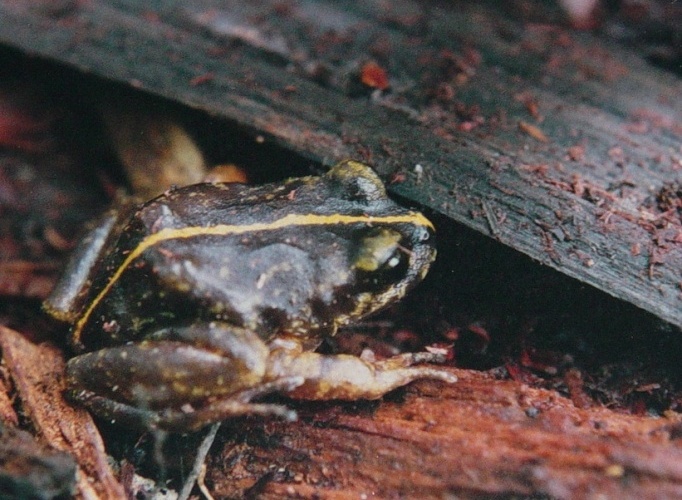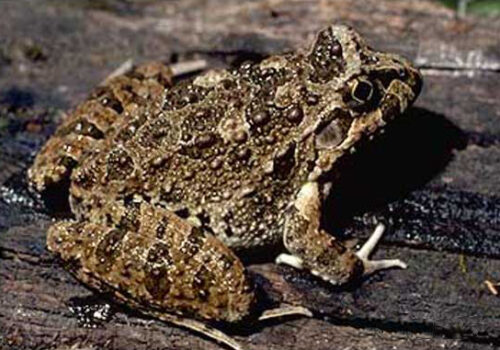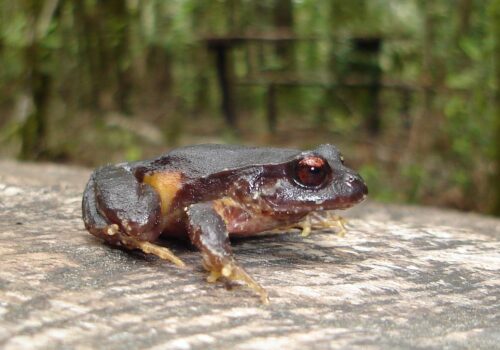- Eupsophus emiliopugini: Discovering Chile's Enchanting Emerald Forest Frog
- Taxonomy and Classification
- Natural Habitat: Secrets Beneath the Forest Floor
- Physical Characteristics: Mastery in Camouflage
- Behavior and Life Cycle: Quiet Lives, Extraordinary Strategies
- Ecological Role: Tiny Guardians of the Rainforest Ecosystem
- Threats and Conservation Status: Stories of Resilience and Vulnerability
- Cultural and Scientific Significance: Small yet Mighty Ambassadors
- Conclusion: Preserving the Forest's Quiet Voice
Eupsophus emiliopugini: Discovering Chile’s Enchanting Emerald Forest Frog#
Deep within the lush forests of southern Chile, there exists a vibrant yet cryptic amphibian, lovingly hidden within leaf-litter layers and moss-draped roots. Eupsophus emiliopugini—commonly known among naturalists as Emilio’s Ground Frog—embodies the captivating beauty and ecological intricacy of temperate rainforest ecosystems. Its humble existence narrates a much broader tale about delicate biodiversity webs, ecological interdependence, and crucially, the fragility of nature in our changing world.
This small, often overlooked frog, measuring no more than a few centimeters, with its varied patterns of coppery browns, greens, and subtle earthy hues, reflects the dynamism of its forested habitat—and yet remains largely enigmatic. Beneath its quiet demeanor rests a surprising blend of remarkable behaviors and adaptations that enchant and compel scientists and nature lovers alike.
Taxonomy and Classification#
Eupsophus emiliopugini belongs to the family Alsodidae, a lineage endemic to Chile and Argentina. Within the genus Eupsophus, the frog finds kinship among celebrated rainforest denizens—amphibians uniquely adapted for life within Chile’s temperate southern forests. Described and cataloged by Formas in 1989, this species’ naming pays homage to Emilio Pugín, an influential Chilean biologist whose passion and efforts contributed significantly to our understanding of southern Chile’s biodiversity.
The genus Eupsophus comprises a unique assemblage of frogs often distinguished by their terrestrial lifestyle, cryptic coloration, and direct developmental life cycle. Unlike many of their amphibian cousins, Emiliopugini’s frogs forego a free-swimming tadpole stage entirely—a fascinating adaptation finely tuned to life beneath the deep humus carpets of southern Chilean rainforests.
Natural Habitat: Secrets Beneath the Forest Floor#
The emerald temperate rainforests of southern Chile, characterized by towering beech and coniferous trees glistening with moisture, form the ideal sanctuary for Eupsophus emiliopugini. La Región de Los Lagos and parts of Los Ríos offer prime habitats—remote, moisture-rich ecosystems cloaked in perpetual mist and drizzle. Here, nature is vibrant and woven thickly into every crevice—from moss-covered rocks and fallen timber to carpets of leaf-litter vibrant with life.
These frogs favor cool, humid microclimates sheltered deep within the forest floor’s leafy substrate. Beneath dense foliage, amid decomposing leaves and earth, they find both camouflage and comfort, blending seamlessly with surroundings saturated in earth tones. The dense, multi-layered vegetation canopy, combined with consistently damp conditions, ensures a stable environment. Such habitats support abundant invertebrate life, providing a steady, reliable food source essential for the species’ survival.
Their natural attachment to pristine, intact forest underscores an important ecological truth—that even slight disturbances or habitat degradation can threaten their delicate existence, amplifying the importance of conserving large, contiguous expanses of undisturbed temperate rainforest areas.
Physical Characteristics: Mastery in Camouflage#
Eupsophus emiliopugini presents nature’s artistry at its most cryptic. Typically small, averaging around 3–4 centimeters long, their compact bodies rest around leaf-litter contours harmoniously. Their skin varies from dark reddish-brown and olive-green hues to earthier tans and browns, intricately patterned with marbling, mottling, and subtle stripes. Such effective cryptic coloration enables them to virtually melt into their surroundings—an evolutionary advantage ensuring stealthy evasion of predators and proficient concealment while hunting invertebrate prey.
A closer observation reveals their rounded pupils—a trait adapted to low-light forest environments. Powerful limbs, designed intricately for hopping short distances, navigating foliage debris, and swiftly digging beneath leaf-litter, facilitate their secretive lifestyle. This exceptional blend of coloration, physical build, and sensory adaptations not only enables survival but exemplifies the evolutionary finesse of nature’s endless innovation.
Behavior and Life Cycle: Quiet Lives, Extraordinary Strategies#
Stealthy Predators of the Forest Floor#
As twilight envelops forest interiors and rain gently drips from leaves overhead, Eupsophus emiliopugini begins its nocturnal routine. Nightfall signals the time to hunt, as small insects, spiders, mites, and other invertebrates roam across damp, leaf-littered soils. Using silent ambush tactics, their predation remains highly efficient yet unobtrusive. The frog waits patiently, blending invisible in the darkened leaf litter until prey approaches, striking with impressive speed and accuracy.
An Intriguing Reproductive Journey#
Unlike many amphibians with explosive mass-breeding events, Emiliopugini’s frogs exhibit a subtler approach suited to the unpredictability of southern rainforest conditions. Breeding occurs seasonally, typically aligning with heavy rainfall that revitalizes their forest-floored habitats.
Males reveal their presence subtly—no grand choruses, merely softly voiced, isolated calls that resonate gently amid dripping foliage. After courtship and pairing, egg laying occurs terrestrially beneath moist logs or directly within sheltered soil pockets rather than in open water sources. Here lies their stunning adaptation—embryos develop directly within gelatinous masses away from traditional aquatic nurseries, entirely bypassing any open water tadpole phase. Tiny froglets emerge intact, fully-formed miniature replicas of their adult counterparts.
Direct development offers clear advantages in dense, temperate rainforest habitats where standing water is scarce and highly ephemeral. This evolutionary strategy markedly decreases vulnerability to aquatic predators and unpredictable water availability alternatives.
Ecological Role: Tiny Guardians of the Rainforest Ecosystem#
Despite their diminutive size and cryptic habits, Eupsophus emiliopugini frogs fulfill vital ecosystem roles within southern Chile’s rainforest web. Predominantly, they act as effective yet discreet invertebrate predators, subtly controlling insect populations. Concurrently, as prey, they support higher trophic-level forest dwellers such as birds and snakes. Their relative abundance and extreme sensitivity to ecological disturbances mark them as important bioindicators, signaling forest health and stability.
By reflecting subtle shifts in microclimate, habitat quality, or contaminant levels, their presence—a muted shade beneath leaf litter—echoes with silent importance. Monitoring their populations informs conservation strategies and communicates, in no uncertain terms, the integrity and future management of Chilean temperate rainforests.
Threats and Conservation Status: Stories of Resilience and Vulnerability#
Presently classified by the International Union for Conservation of Nature (IUCN) as “Near Threatened,” Eupsophus emiliopugini faces significant environmental threats, primarily habitat loss driven by deforestation linked to logging, agriculture, and infrastructure development. Climate change further intent upon altering precipitation patterns, temperature stability, and humidity regimes—key elements sustaining their unique habitat conditions—poses an additional, pervasive threat.
Beyond habitat destruction, disease poses another emerging concern. Amphibians globally are experiencing the devastating impacts of the chytrid fungus, resulting in mass die-offs. Vigilant, proactive conservation measures—encompassing habitat preservation, ecological research, pathogen surveillance, and sustainable land-use policies—become imperative to safeguard these discrete ambassadors of Chile’s biodiversity.
Cultural and Scientific Significance: Small yet Mighty Ambassadors#
Beyond intrinsic ecological worth, Eupsophus emiliopugini contributes significantly culturally and scientifically. Locally, they represent the rich faunal tapestry emblematic of Chile’s unique southern forests—sources of pride and connection for local communities. Scientifically, their presence, ecological adaptations, and responses to environmental changes provide essential insight into evolutionary biology, climate-change impacts, and the complexities inherent within forest ecosystems.
As researchers increasingly recognize their value, Emilio’s frogs guide conservation philosophy—immersing us in a narrative of interconnectedness, illustrating vividly the harmony required between human development and ecological balance to sustain biodiversity.
Conclusion: Preserving the Forest’s Quiet Voice#
The fascinating Eupsophus emiliopugini, quietly residing beneath leaf-litter shadows of Chilean temperate rainforests, exemplifies nature’s incredible adaptability alongside its innate fragility. Protecting this subtle forest sentinel calls for dedicated conservation efforts encompassing strong habitat safeguards, ongoing research initiatives, public awareness, and sustainable development practices.
To protect Eupsophus emiliopugini is to commit ourselves not merely to preserving one species, but to acknowledging the essential interconnectedness all life shares across fragile forest floors, misty understories, and rich biodiversity webs. May we choose resolutely to hear—and heed—the quiet yet powerful voice echoed within Chile’s enchanting emerald forests.










